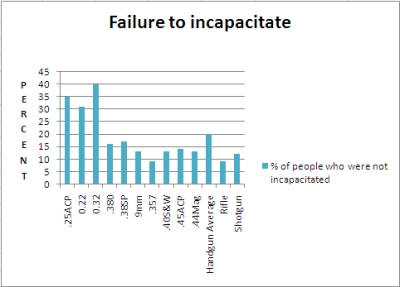44 AMP said:
The OP was about how Docs can't tell what (or rather which) of the common defensive calibers was used from the wound track. Ok, fine. I got that, DOCS can't tell that. Makes sense, the difference in size between the common rounds is small, and tissue is elastic.
Really my OP was to shift focus and energy from arguing about calibers, terminal ballistics, and projectile composition to discussing the importance of good defensive shooting. Bigger does not mean better especially if you can't hit your target.
In terms of medical examination after an individual has been shot it doesn't matter what caliber was used. The damage is either fatal, critical, or superficial. The entire point of the OP was the ALL calibers, big and small, can create superficial wounds that wouldn't stop a rat from eating your cheese.
Any caliber, shot well with the intent to do MAJOR bodily harm will achieve that end. This includes .22 LR and everything beyond that. If you think a .22 pistol won't kill, people like Robert Kennedy and Mark Coates have a story for you. To see examples of how poor shooting with any caliber is ineffective one need only search for the scores of people shot DOZENS of times with "service calibers" only to survive, continue to fight, or flee.
Now, I will dip into projectile composition a little as a bullet that is designed to do "something" upon impact MAY increase your chances or damaging a critical area... However don't buy into "wound channels" and gel testing. The human body is not a solid mass. It has compartments and organs that are enveloped in tough sheets of protective material. There is fascia and connective tissue that have different strengths and characteristics. The "expanding" channels seen in gel may just politely move organs aside in living tissue.
If they could develop a 9mm round that penetrated 3 inches into its target and then explode violently I would buy it in a heartbeat.
This G2 RIP stuff looks interesting, though...
We do have some data on the subject from
an article by Ellefritz:
But what do these numbers even mean? In a vacuum it looks as if a .22 is the worst and everyone should grab a .357! However, this may be due to the fact that a .22 is common and many novice shooter use them. I don't think there are too many brand new, untrained, and undisciplined shooters who jump straight for a .357. It is logical to assume that .357s seem to incapacitate successfully more often because they are being SHOT by better shooters...
Now look at this data:
Wow. Those .22s don't look so bad! Wait a minute... It couldn't have ANYTHING to do with the sheer VOLUME of that caliber being used, could it?
Well-placed shots have the desired effect. Regardless of caliber. Regardless of load.
Now, as I've stated before, if you can shoot your .357 or .45 just as well or better than a smaller caliber, go for it... And, I wouldn't choose a .22 for defense because rim-fire is historically less reliable than center-fire. I do want to KNOW my gun will go boom when I squeeze the trigger. Some with more reliable .22 pistols may think differently... And, obviously, 22s have been used effectively for everything from self-defense to assassinations.
But, please... Preach a gospel of training, knowledge, and skill development before waxing poetic on calibers. As a man who hasn't been carrying or shooting as long as many of you I would appreciate advice on improving my effectiveness before you start pointing me to heavier bullets. The WORLD would appreciate it.
That being said, I do appreciate an energetic discussion on any topic. And, all of you are bringing a lot to the plate. Keep it civil, keep it on topic, and I will continue to read and post!





